heating RENAULT TWINGO 2009 2.G Heating And Air Conditioning - Manual Air Conditioning Owner's Manual
[x] Cancel search | Manufacturer: RENAULT, Model Year: 2009, Model line: TWINGO, Model: RENAULT TWINGO 2009 2.GPages: 63
Page 45 of 63
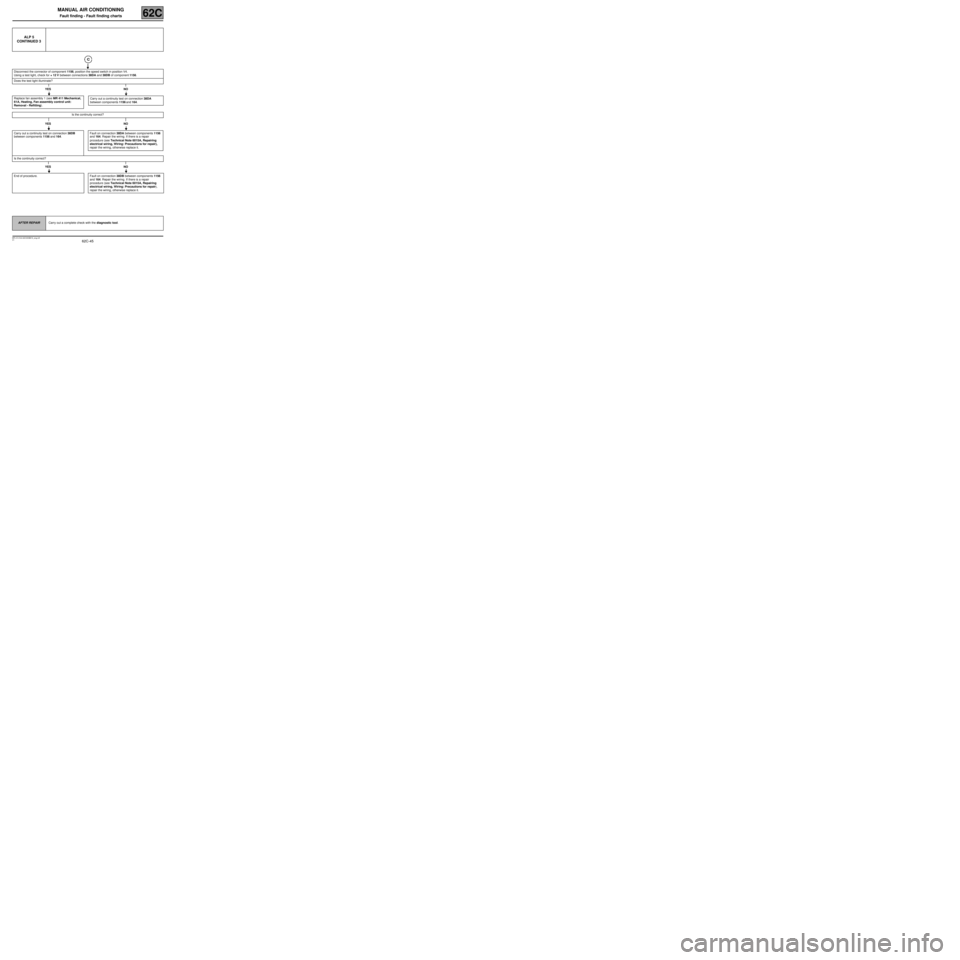
62C-45
MR-413-X44-62C000$819_eng.mif
V1
MANUAL AIR CONDITIONING
Fault finding - Fault finding charts62C
ALP 5
CONTINUED 3
Disconnect the connector of component 1156, position the speed switch in position V4.
Using a test light, check for + 12 V between connections 38DA and 38DB of component 1156.
Does the test light illuminate?
YES NO
Replace fan assembly 1 (see MR 411 Mechanical,
61A, Heating, Fan assembly control unit:
Removal - Refitting).
Is the continuity correct?
YES NO
Carry out a continuity test on connection 38DB
between components 1156 and 164.
Is the continuity correct?
YES NO
End of procedure. Fault on connection 38DB between components 1156
and 164. Repair the wiring. If there is a repair
procedure (see Technical Note 6015A, Repairing
electrical wiring, Wiring: Precautions for repair),
repair the wiring, otherwise replace it.
Carry out a continuity test on connection 38DA
between components 1156 and 164.
Fault on connection 38DA between components 1156
and 164. Repair the wiring. If there is a repair
procedure (see Technical Note 6015A, Repairing
electrical wiring, Wiring: Precautions for repair),
repair the wiring, otherwise replace it.
AFTER REPAIRCarry out a complete check with the diagnostic tool.
Page 49 of 63
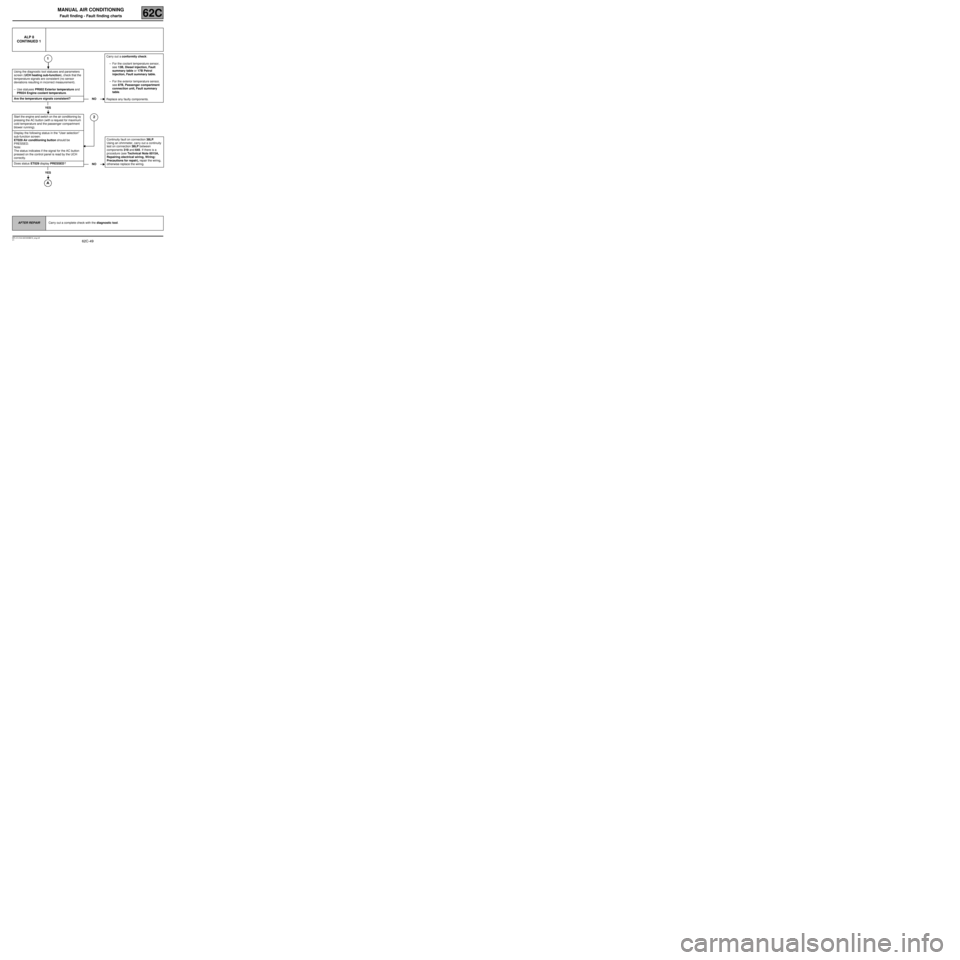
62C-49
MR-413-X44-62C000$819_eng.mif
V1
MANUAL AIR CONDITIONING
Fault finding - Fault finding charts62C
ALP 8
CONTINUED 1
1
Using the diagnostic tool statuses and parameters
screen (UCH heating sub-function), check that the
temperature signals are consistent (no sensor
deviations resulting in incorrect measurement).
–Use statuses PR002 Exterior temperature and
PR024 Engine coolant temperature.
Are the temperature signals consistent?
YES
Start the engine and switch on the air conditioning by
pressing the AC button (with a request for maximum
cold temperature and the passenger compartment
blower running).
2
Display the following status in the “User selection”
sub-function screen:
ET029 Air conditioning button should be
PRESSED.
Note:
The status indicates if the signal for the AC button
pressed on the control panel is read by the UCH
correctly.
Does status ET029 display PRESSED?
YES
NOCarry out a conformity check:
–For the coolant temperature sensor,
see 13B, Diesel injection, Fault
summary table or 17B Petrol
injection, Fault summary table.
–For the exterior temperature sensor,
see 87B, Passenger compartment
connection unit, Fault summary
table.
Replace any faulty components.
NOContinuity fault on connection 38LP.
Using an ohmmeter, carry out a continuity
test on connection 38LP between
components 319 and 645. If there is a
procedure (see Technical Note 6015A,
Repairing electrical wiring, Wiring:
Precautions for repair), repair the wiring,
otherwise replace the wiring.
AFTER REPAIRCarry out a complete check with the diagnostic tool.
Page 55 of 63
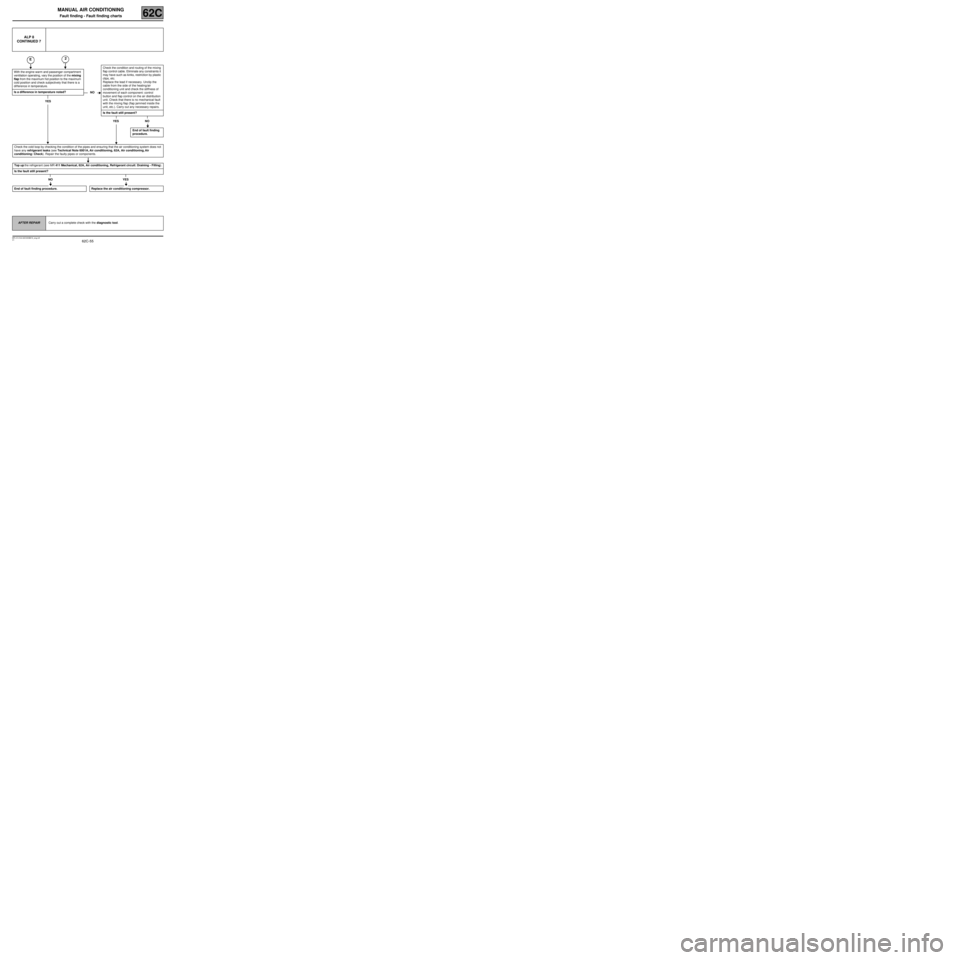
62C-55
MR-413-X44-62C000$819_eng.mif
V1
MANUAL AIR CONDITIONING
Fault finding - Fault finding charts62C
ALP 8
CONTINUED 7
2
With the engine warm and passenger compartment
ventilation operating, vary the position of the mixing
flap from the maximum hot position to the maximum
cold position and check subjectively that there is a
difference in temperature.
Is a difference in temperature noted?
YES
E
NOCheck the condition and routing of the mixing
flap control cable. Eliminate any constraints it
may have such as kinks, restriction by plastic
clips, etc.
Replace the lead if necessary. Unclip the
cable from the side of the heating/air
conditioning unit and check the stiffness of
movement of each component: control
button and flap control on the air distribution
unit. Check that there is no mechanical fault
with the mixing flap (flap jammed inside the
unit, etc.). Carry out any necessary repairs.
Is the fault still present?
YES NO
End of fault finding
procedure.
Check the cold loop by checking the condition of the pipes and ensuring that the air conditioning system does not
have any refrigerant leaks (see Technical Note 6001A, Air conditioning, 62A, Air conditioning, Air
conditioning: Check). Repair the faulty pipes or components.
Top up the refrigerant (see MR 411 Mechanical, 62A, Air conditioning, Refrigerant circuit: Draining - Filling).
Is the fault still present?
NO YES
End of fault finding procedure. Replace the air conditioning compressor.
AFTER REPAIRCarry out a complete check with the diagnostic tool.
Page 56 of 63
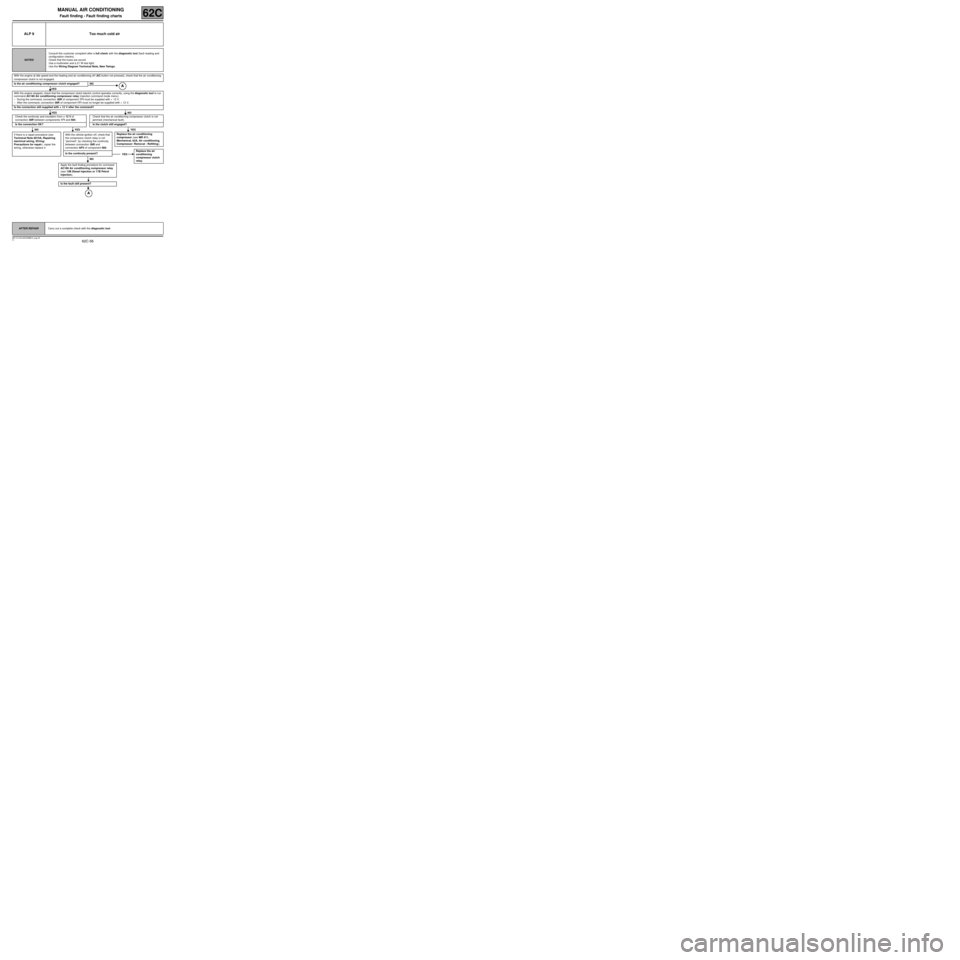
62C-56
MR-413-X44-62C000$910_eng.mif
V1
62C
MANUAL AIR CONDITIONING
Fault finding - Fault finding charts
ALP 9 Too much cold air
NOTESConsult this customer complaint after a full check with the diagnostic tool (fault reading and
configuration checks).
Check that the fuses are sound.
Use a multimeter and a 21 W test light.
Use the Wiring Diagram Technical Note, New Twingo.
With the engine at idle speed and the heating and air conditioning off (AC button not pressed), check that the air conditioning
compressor clutch is not engaged.
Is the air conditioning compressor clutch engaged? NO
YES
With the engine stopped, check that the compressor clutch electric control operates correctly, using the diagnostic tool to run
command AC180 Air conditioning compressor relay (injection command mode menu).
–During the command, connection 38R of component 171 must be supplied with + 12 V.
–After the command, connection 38R of component 171 must no longer be supplied with + 12 V.
Is the connection still supplied with + 12 V after the command?
YES NO
Check the continuity and insulation from + 12 V of
connection 38R between components 171 and 584.Check that the air conditioning compressor clutch is not
jammed (mechanical fault).
Is the connection OK? Is the clutch still engaged?
NO YES YES
If there is a repair procedure (see
Technical Note 6015A, Repairing
electrical wiring, W iring:
Precautions for repair), repair the
wiring, otherwise replace it.With the vehicle ignition of f, check that
the compressor clutch relay is not
“jammed”, by checking the continuity
between connection 38R and
connection AP3 of component 584.
Is the continuity present?
NO
Apply the fault finding procedure for command
AC180 Air conditioning compressor relay
(see 13B Diesel injection or 17B Petrol
injection).
Is the fault still present?
Replace the air conditioning
compressor (see MR 411,
Mechanical, 62A, Air conditioning,
Compressor: Removal - Refitting).
YESReplace the air
conditioning
compressor clutch
relay.
AFTER REPAIRCarry out a complete check with the diagnostic tool.
MR-413-X44-62C000$910_eng.mif
Page 57 of 63
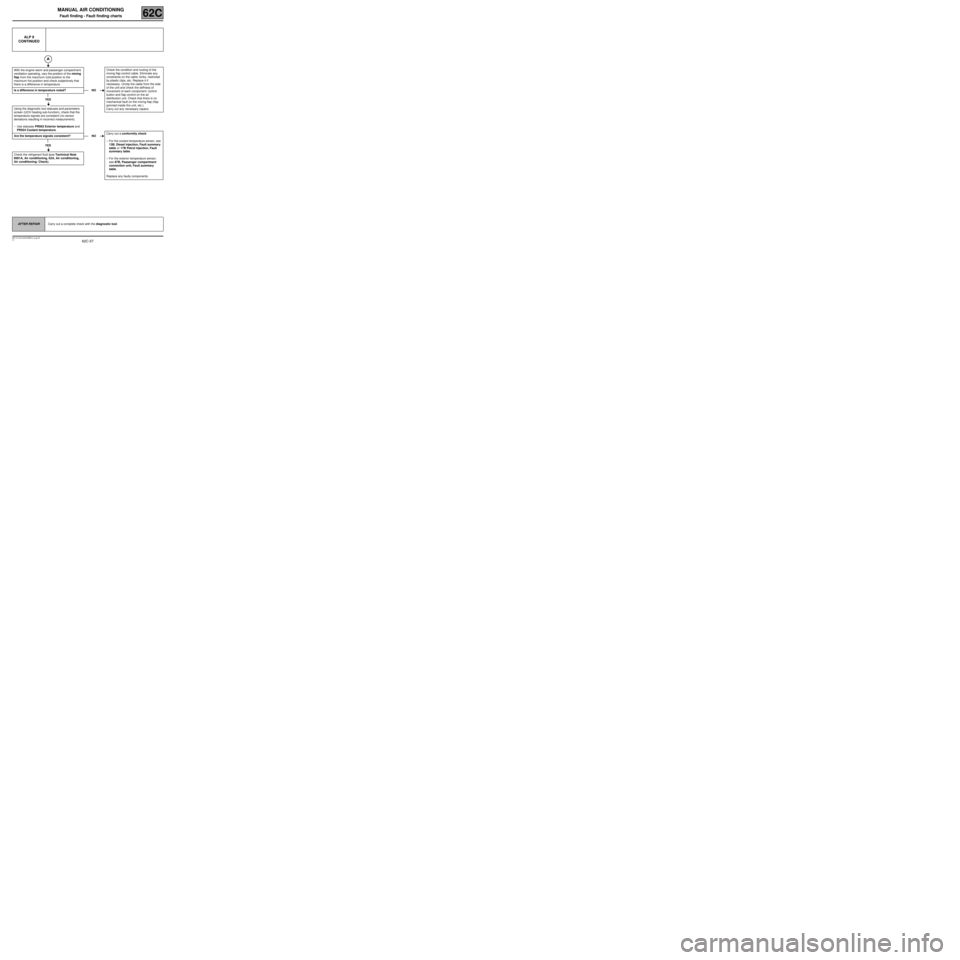
62C-57
MR-413-X44-62C000$910_eng.mif
V1
MANUAL AIR CONDITIONING
Fault finding - Fault finding charts62C
ALP 9
CONTINUED
With the engine warm and passenger compartment
ventilation operating, vary the position of the mixing
flap from the maximum cold position to the
maximum hot position and check subjectively that
there is a difference in temperature.
Is a difference in temperature noted?
YES
Using the diagnostic tool statuses and parameters
screen (UCH heating sub-function), check that the
temperature signals are consistent (no sensor
deviations resulting in incorrect measurement).
–Use statuses PR002 Exterior temperature and
PR024 Coolant temperature.
Are the temperature signals consistent?
YES
Check the refrigerant fluid (see Technical Note
6001A, Air conditioning, 62A, Air conditioning,
Air conditioning: Check).
NOCheck the condition and routing of the
mixing flap control cable. Eliminate any
constraints on the cable: kinks, restricted
by plastic clips, etc. Replace it if
necessary. Unclip the cable from the side
of the unit and check the stiffness of
movement of each component: control
button and flap control on the air
distribution unit. Check that there is no
mechanical fault on the mixing flap (flap
jammed inside the unit, etc.).
Carry out any necessary repairs.
NOCarry out a conformity check:
–For the coolant temperature sensor, see
13B, Diesel injection, Fault summary
table or 17B Petrol injection, Fault
summary table.
–For the exterior temperature sensor,
see 87B, Passenger compartment
connection unit, Fault summary
table.
Replace any faulty components.
AFTER REPAIRCarry out a complete check with the diagnostic tool.
Page 60 of 63
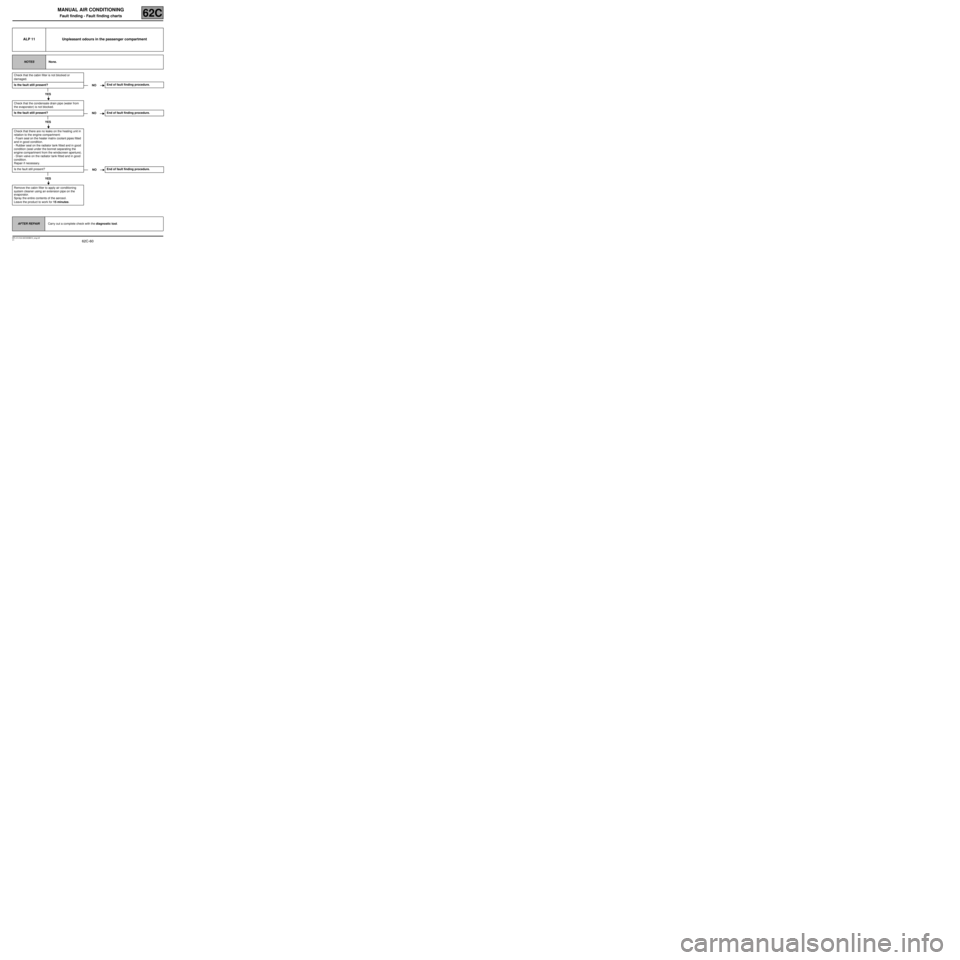
62C-60
MR-413-X44-62C000$910_eng.mif
V1
MANUAL AIR CONDITIONING
Fault finding - Fault finding charts62C
ALP 11 Unpleasant odours in the passenger compartment
NOTESNone.
Check that the cabin filter is not blocked or
damaged.
Is the fault still present?
YES
Check that the condensate drain pipe (water from
the evaporator) is not blocked.
Is the fault still present?
YES
Check that there are no leaks on the heating unit in
relation to the engine compartment:
- Foam seal on the heater matrix coolant pipes fitted
and in good condition.
- Rubber seal on the radiator tank fitted and in good
condition (seal under the bonnet separating the
engine compartment from the windscreen aperture).
- Drain valve on the radiator tank fitted and in good
condition.
Repair if necessary.
Is the fault still present?
YES
Remove the cabin filter to apply air conditioning
system cleaner using an extension pipe on the
evaporator.
Spray the entire contents of the aerosol.
Leave the product to work for 15 minutes.
NOEnd of fault finding procedure.
NOEnd of fault finding procedure.
NOEnd of fault finding procedure.
AFTER REPAIRCarry out a complete check with the diagnostic tool.
Page 63 of 63
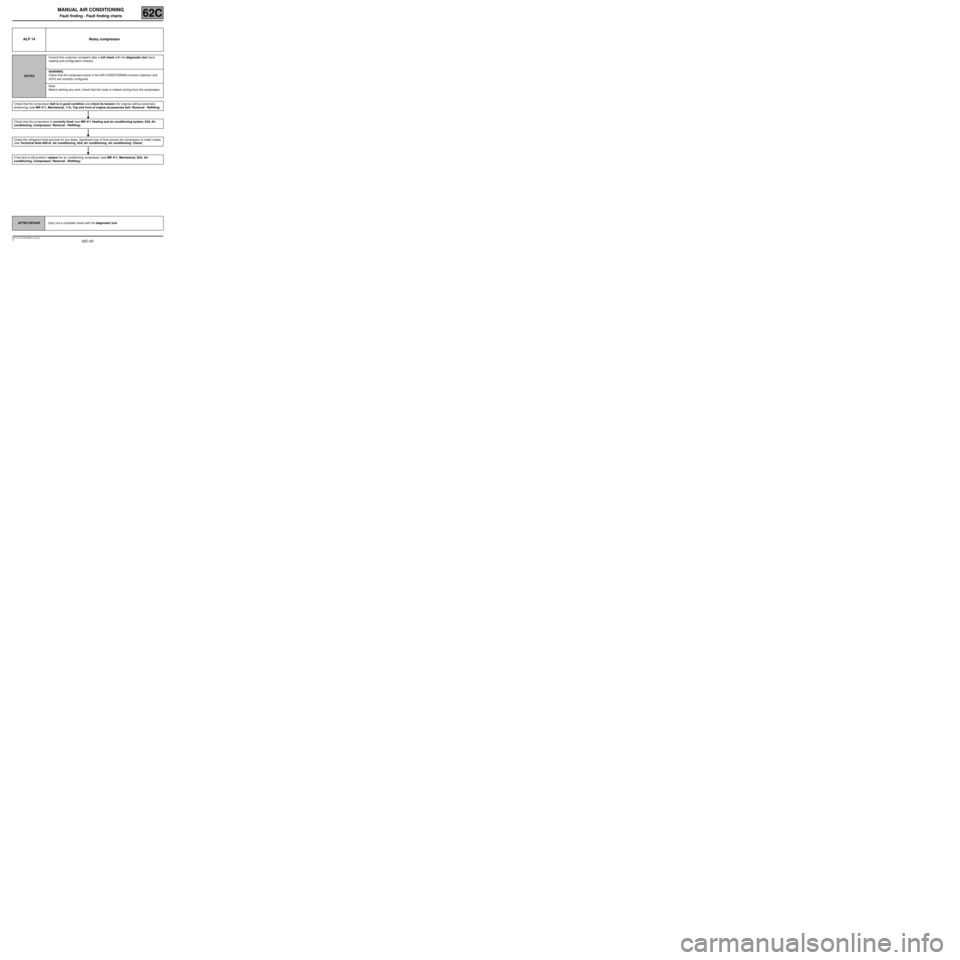
62C-63
MR-413-X44-62C000$910_eng.mif
V1
MANUAL AIR CONDITIONING
Fault finding - Fault finding charts62C
ALP 14 Noisy compressor
NOTESConsult this customer complaint after a full check with the diagnostic tool (fault
reading and configuration checks).
WARNING
Check that the computers active in the AIR CONDITIONING function (Injection and
UCH) are correctly configured.
Note:
Before starting any work, check that the noise is indeed coming from the compressor.
Check that the compressor belt is in good condition and check its tension (for engines without automatic
tensioning) (see MR 411, Mechanical, 11A, Top and front of engine, Accessories belt: Removal - Refitting).
Check that the compressor is correctly fixed (see MR 411 Heating and air conditioning system, 62A, Air
conditioning, Compressor: Removal - Refitting).
Check the refrigerant fluid and look for any leaks. Significant loss of fluid causes the compressor to make noises.
(see Technical Note 6001A, Air conditioning, 62A, Air conditioning, Air conditioning: Check).
If the fault is still present, replace the air conditioning compressor (see MR 411, Mechanical, 62A, Air
conditioning, Compressor: Removal - Refitting).
AFTER REPAIRCarry out a complete check with the diagnostic tool.